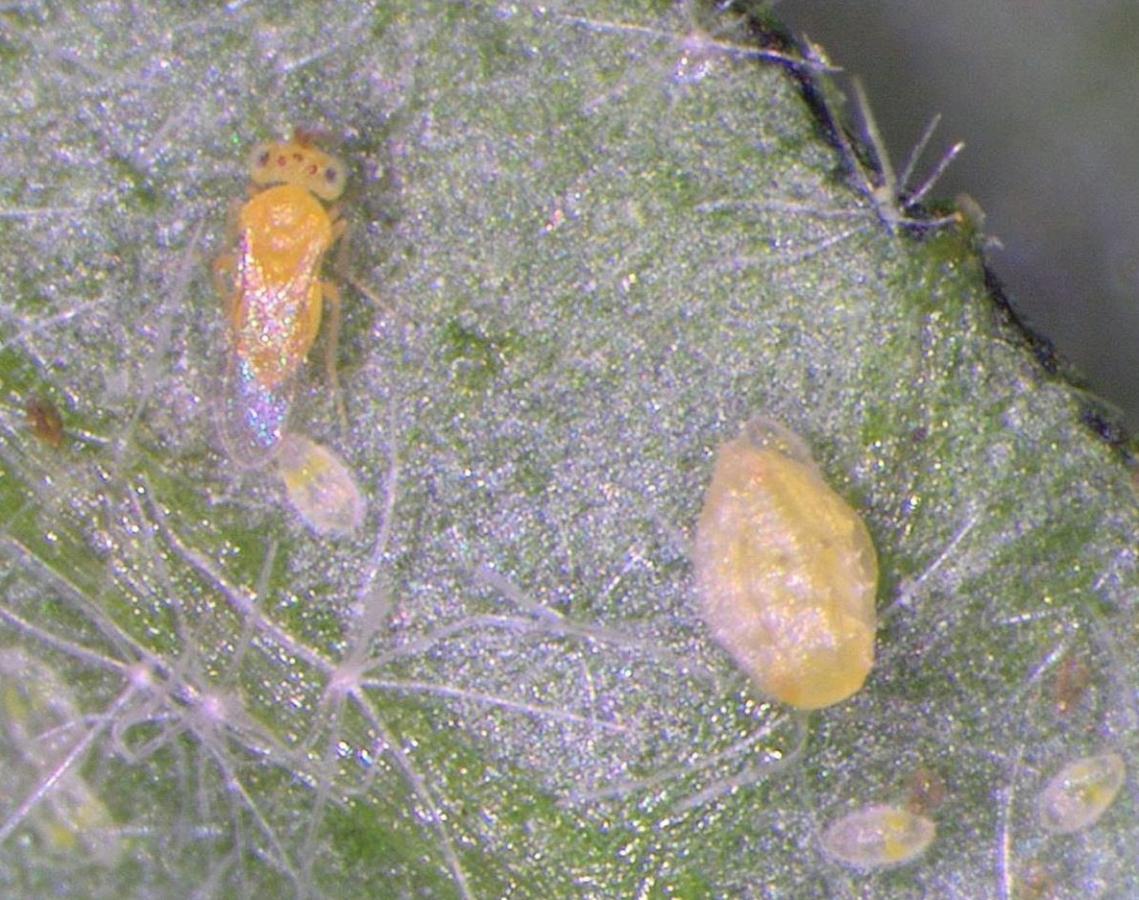Eretmocerus Eretmocerus hayati
Eretmocerus hayati is a small parasitic wasp that attacks Silverleaf whitefly (Bemisia tabaci) in vegetable, cotton, melon, grain legume, and ornamental crops. E. hayati has the highest reported biological control potential of Silverleaf whitefly and has established well in the tropical and subtropical agricultural growing regions of Australia. More recently, Silverleaf whitefly has been migrating further south into Victoria and south-west Western Australia.
Description and life cycle
E. hayati are minute wasps about 0.5mm-1mm long. Females have bright yellow bodies with clubbed antennae. Males have longer antennae with some black markings and overall are darker yellow in color. Males and females occur in almost equal in numbers and the complete life cycle takes about 4 weeks. Female wasps lay their eggs under the whitefly nymphs, the larvae hatch from eggs and then penetrate the nymph bodies. Parasitised nymphs show displaced mycetomes on the edges of the nymph body, while in unparasitised nymphs, the mycetomes are parallel and symmetrical. Development takes about 12 to 32 days at 30°C and 20°C, respectively. Wasp larvae develop through 4 instar stages before pupating inside the whitefly body. When the adult is ready to emerge, it chews a circular hole in the nymphal case to escape.
Suitable crops
E. hayati can be used on all crops where Silverleaf whitefly is present. Silverleaf whitefly can reproduce and feed to varying degrees on more than 600 plant species. Vegetable crops such as tomato, eggplants, squash, brassicas, zucchini, lettuce and beans are very good hosts of Silverleaf whitefly. Many ornamentals including poinsettia, hibiscus, chrysanthemum, begonia, fuchsia, roses and gerbera are affected. Other widely grown field crops like melons, cotton and grain legumes are also common hosts of the pest.
When to release
E. hayati works best when used preventatively. Silverleaf whitefly can increase rapidly so it is recommended to release parasites before whitefly are detected, or when the very first whiteflies are noticed in the crop. If whitefly density is already high, it is advisable to use non-disruptive insecticides to help lower the whitefly population density prior to and during releases.
How to release
E. hayati are sent as loose pupae in plastic vials (2500/vial). They can be sprinkled over the top of foliage or open the vial and leave it resting sideways in the canopy so the adult wasps can fly freely onto the target plants. Do not place vials/pupae on the ground or pupae may be eaten by ants. If ants are present, control them with baits prior to and during release periods.
E. hayati releases should be spread throughout the crop and also concentrated into known hotspots. In tall vine crops like tomatoes, pupae can be released into bio boxes which are hung in the crops.
Recommended release rates
For field crops
Inoculative releases of 5000 wasps/ha should be repeated weekly or fortnightly for at least five releases. The first release should be conducted preventatively or when the very first adult whiteflies are noticed. It is advised to conduct extra releases and increase rates where high whitefly intensity is present.
For greenhouse crops
Release preventatively at 1 wasp/m2 weekly. Increase weekly release rates to 2/m2 at the very first signs of whitefly and continue releases until parasitism reaches 80 per cent. Increase the recommended rate when the whitefly density is already high. Hot spots should receive 5-10 wasps/m2 weekly to build the parasite populations quickly.
Storage
E. hayati should be released as soon as received, but if not, store at 8-10°C for 1-2 days only.
Chemical use
E. hayati have shown tolerance to many pesticides and can re-establish more quickly than many other parasites after pesticide use. However, pyrethroids, organophosphate and neonicotinoids with long residual actions are detrimental. Check side-effects charts carefully and avoid using toxic pesticides at least 4 weeks before and during Eretmocerus use unless they are known to be safe. Contact Biological Services for specific information.
Ordering and accounts
Orders are sent via express courier services on Monday or Tuesday of each week, and usually arrive within a couple of days. Orders received after noon on Tuesday are sent the following Monday. Freight is charged at cost.
Accounts are sent at the end of each month, and can be paid by EFT, BPay, cheque or postal order.

Related pests
Related crops
- Brassicas
- Cotton
- Cucurbits
- Flowers/ornamentals
- Greenhouse eggplants
- Greenhouse tomatoes
- Legumes
- Melons
- Nursery






